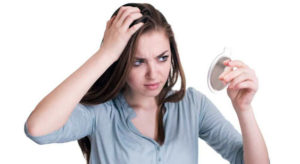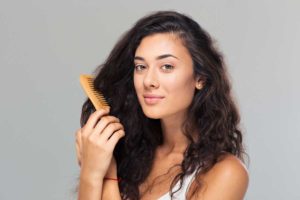We had a request to talk about head lice in our newsletter, and while it certainly is not fun to talk about, we are getting ready for school season again. And while children tend to be the overwhelming majority of head-lice sufferers, adults get them, too. So, go ahead and itch….it’s okay. Let’s talk about head lice.
What are they?
Lice are parasites that infest only humans. They do not transmit disease. They are spread from hair-to-hair contact. They crawl from location to location (they cannot jump or fly, thank goodness!). The adults lay eggs for 28 days. The eggs, or “nits” are glued to the base of the hair for 8-10 days. Once hatched, they grow for about 10 days before becoming adults.
Adults can only survive without a human host for 48 hours. According to the CDC (Centers for Disease Control), nits cannot hatch and usually die within a week if not kept at the same temperature as the scalp.
Lice are about the size of a sesame seed, and are found most often around the nape of the neck and behind the ears. They do not like bright lights, so parting the hair and shining a light on the head should allow you to see them move.
Treatments
Lice tend to elicit strong feelings, both from the people who get them, and the people around them. The first thing is remember to keep your head (sorry for the pun, but let’s lighten things up a big). Despite all the horror stories we’ve all heard about infestations that would not go away, lice do not have to be a big deal. Yes….I said it. They are not a big deal. Here are your options:

Over-the-counter shampoos –Shampoos like Rid or Nix contain pesticides. They kill lice, but not nits. They often require a second shampooing, and in order to be totally effective, require “nit picking”, or combing out the hair with special nit combs to remove nits (flea combs from the pet store may work, too).
Prescription shampoos – These are usually Ovide or Lindane. They are most often a second line of defense for resistant lice. They kill lice and eggs, but should only be used once. Not everyone can be exposed to these shampoos, and there are some very scary accounts on the internet of these shampoos making some people really, REALLY sick, or worse. These treatments also require combing out the hair to be totally effective.
Ulestia – This is one of several products that are over-the-counter and actually smother lice. Once used, the hair needs to be combed out.
At home treatments – These include using olive oil, coconut oil, shampoos with tea tree oil, peppermint oil, eucalyptus oil, rosemary oil, and more. These treatments smother or kill lice and nits, and require the hair to be combed out. Using oils, like olive oil or coconut oil (which contains a fatty acid that actually breaks down the exoskeleton of lice), may be messy, but it allows for a gentler experience during combing, and is also very good for the hair. Just apply liberally, cover the head with a towel, and leave on for an hour or so. Then, comb out, and wash (maybe twice).
Homeopathic treatments – There were many homeopathic treatments on the internet with positive feedback. These treatments say they kill both lice and nits, and are harmless to humans. Combing is a critical part of effective treatment here as well.
For the Home
As for the house, the American Academy of Pediatrics says you only have to clean anything in the house that has had contact with the infected person’s head within 24-48 hours before treatment – not everything in the house. Vacuuming is quite effective for furniture and carpet. The CDC says that the lice will die with exposure to temperatures over 128.3 F for 5 minutes (launder with hot water and a hot dryer). They also say that using fumigant sprays or fogs to treat lice is a bad idea.
There are some that believe that many strains of lice have become resistant to the pesticides used in over-the-counter and prescription shampoos. Others believe that the failure to get rid of lice means that the hair was not properly combed out, or the person was reinfested from the original source. If treatment with a pesticide shampoo fails, don’t just retreat or switch to another, these aren’t just shampoo. Regardless of which treatment is appealing, all ways of treating lice effectively seem to ultimately depend on proper combing of the hair, and rechecking for live lice 7-9 days after treatment – so invest in a really good lice comb and prepare for battle. Since that is the underlying cause for success no matter which way lice is treated, make that the primary focus, and really think about whether you want to use pesticides because you just want them dead, or because it is the most effective treatment.
Prevention
I found reference to two studies that tea tree oil kills lice. The first study shows that tea tree oil is as effective as the main ingredient in the pesticides in killing lice. The second study compares tea tree oil to DEET. Tea tree oil is also thought to prevent lice by masking our scent. Because it is also toxic to lice, it will kill any that happen to crawl onto the hair as well. The oil can be added to shampoo you already have, or you can buy shampoos with it already in it. Tea tree oil can cause skin irritation, so be careful if you are making your own, and quit using the shampoo if the scalp becomes irritated.
In conclusion, the best way to combat lice is effective combing of the hair and periodic rechecks. Believe it or not, there are professional nit pickers out there, but it can be done effectively at home with a good lice comb and some patience. Total house sterilization is also a belief of the past, thankfully. And essential oils like tea tree are thought to deter the little pests from our little pests. So consider switching shampoos for back-to-school. Of course, if you would like a recommendation for a good one, we have several we sell and think highly of.
Thank you for making it through to the end. You can stop scratching your head now.

Have a beauty-related question? We'd love to hear it, and so would our readers. Email your questions to Westside Beauty Supply.
We’d love to help.
If you don't have a stylist or esthetician you work with, give us a call and we'll set up an appointment to help you with your skin-care or hair-care products. We have several make-up artists who are happy to help you find new colors and techniques that make you feel beautiful. Letting us know when you are coming in will ensure we can give you all our attention. This is a free service, and there is no obligation to buy our products.



